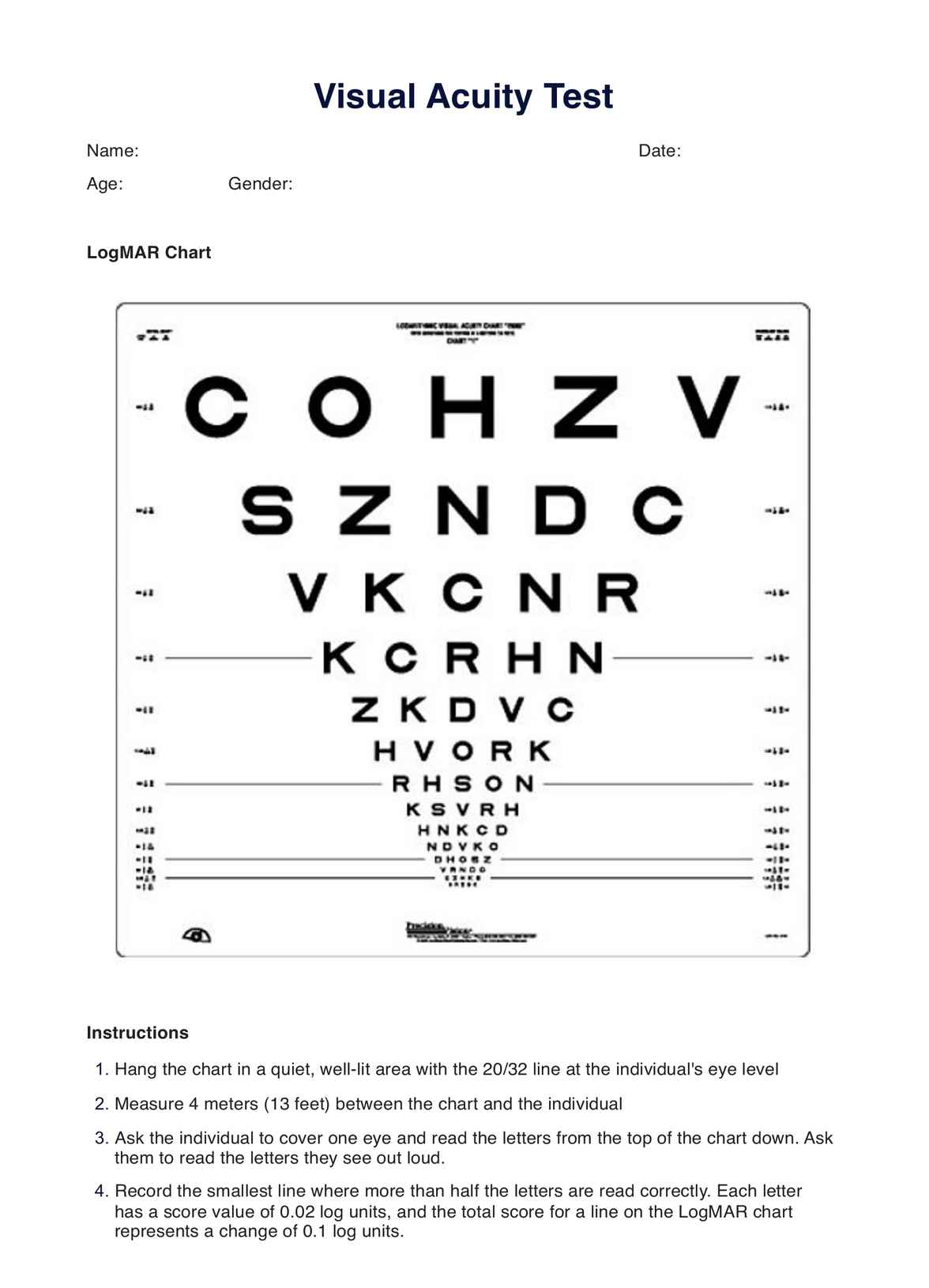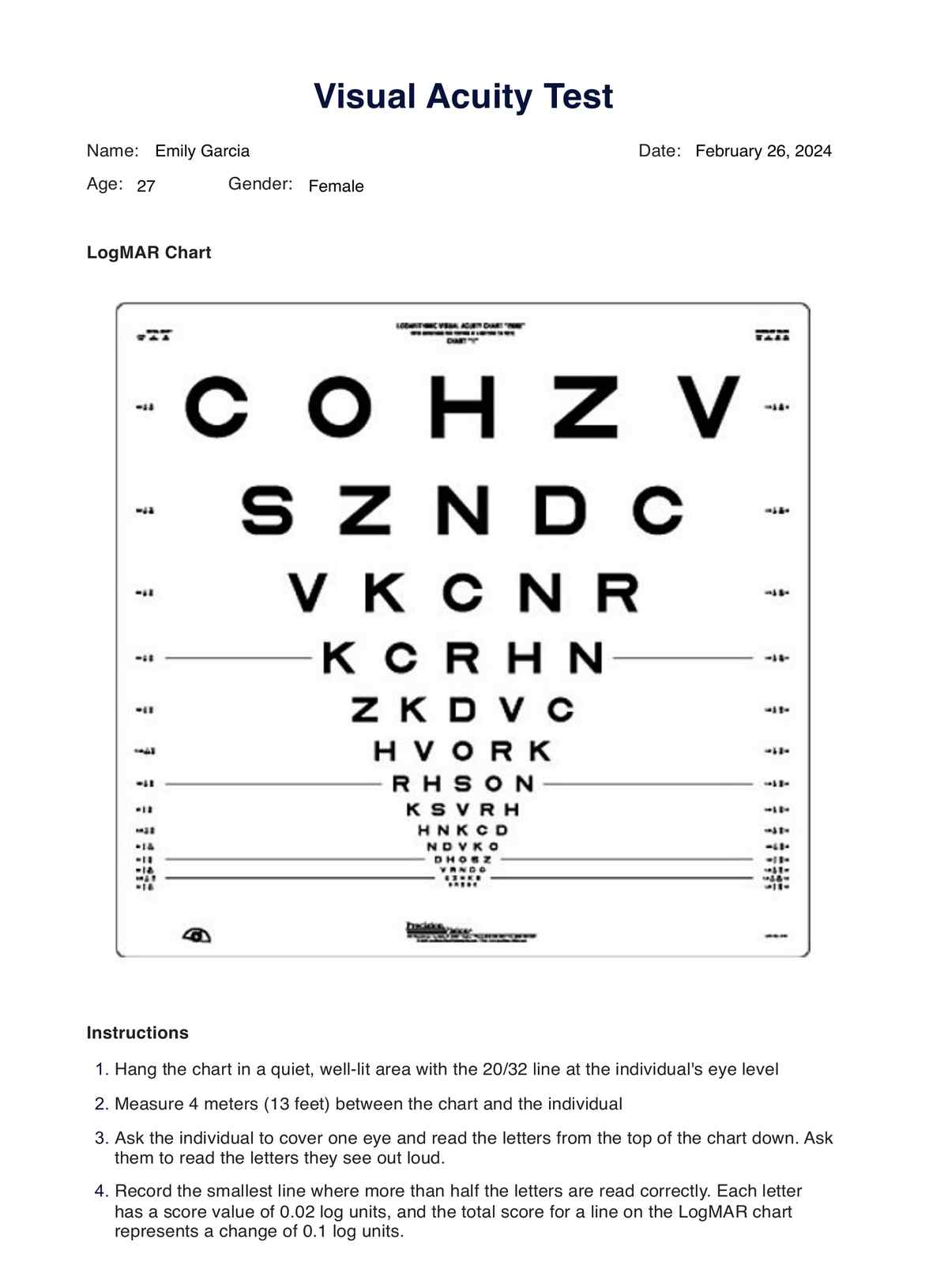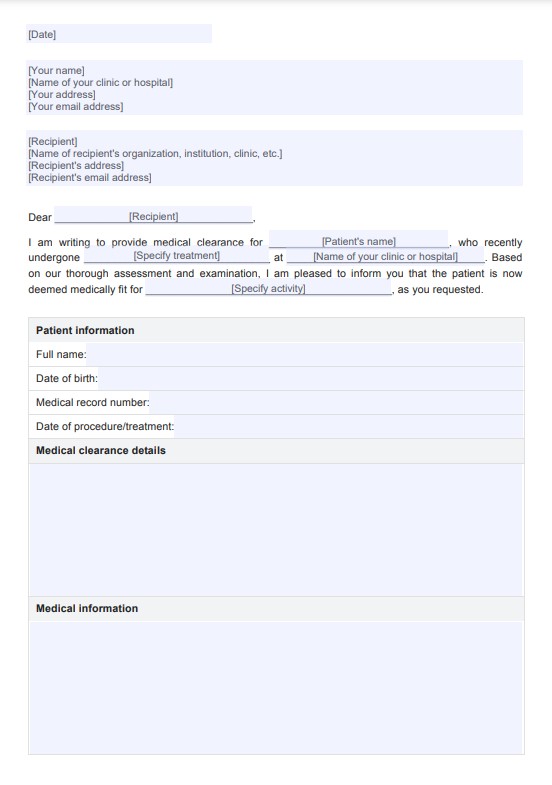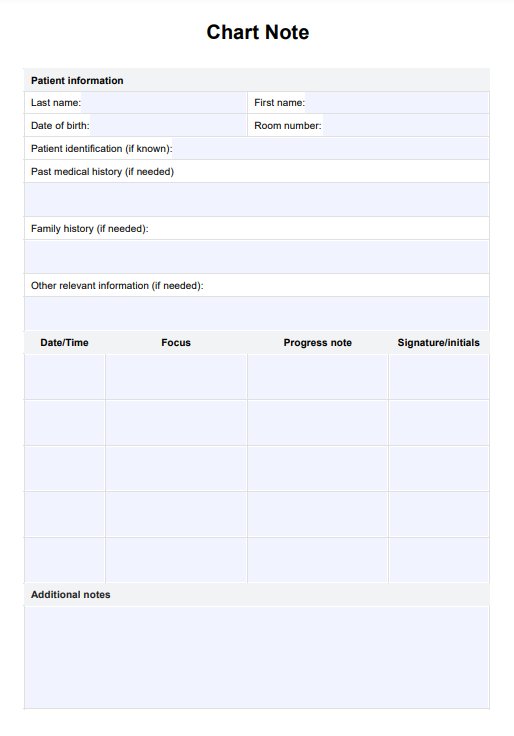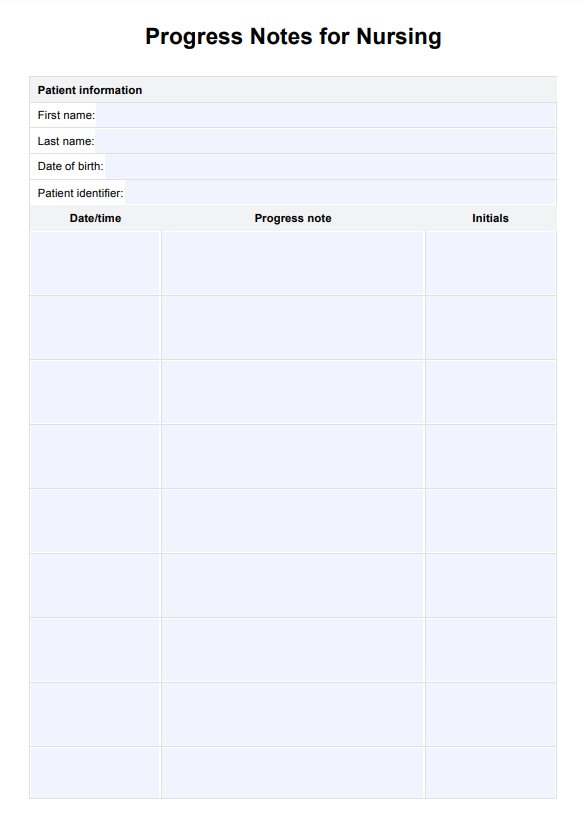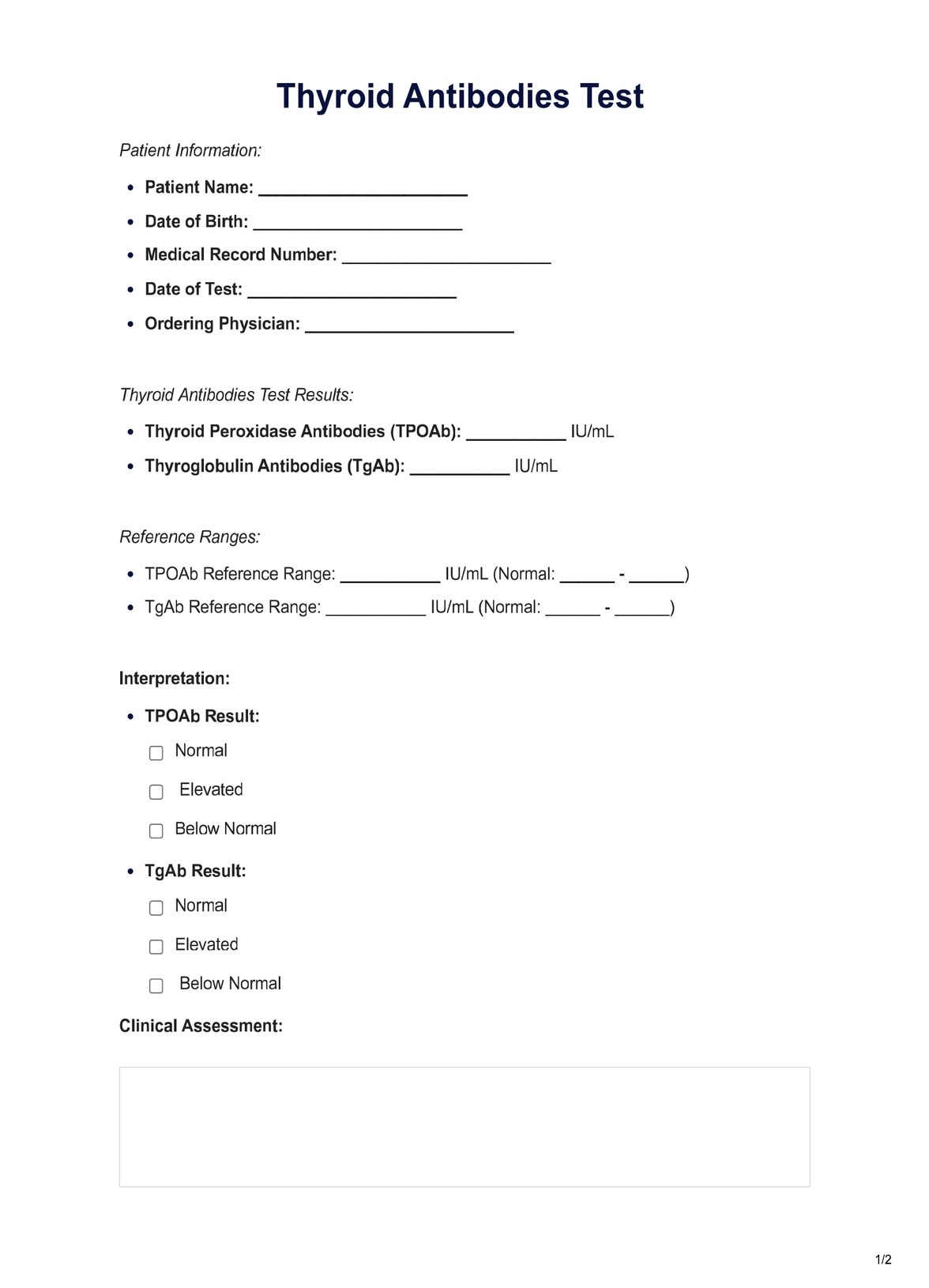Visual Acuity Test
Download this Visual Acuity Test template to measure patients' clarity of vision and learn about its importance in eye examinations.


What is visual acuity?
Visual acuity refers to the clarity or sharpness of one's vision. In other words, visual acuity is a quantitative assessment of the eye's ability to make out shapes and the details of objects at a distance. It's not just about how small a letter an individual can read but also how well they can perform tasks that require sharp vision. It gauges the eye's capacity to resolve spatial detail, which is critical for most visual tasks in our everyday life.
Normal visual acuity, commonly called "20/20 vision" or "6/6 vision," indicates that a person can see the standard at the measured distance. Having less than normal visual acuity (e.g., 20/40, 6/12, etc.) is a signal to dig deeper into the underlying causes.
Visual acuity decreases for various reasons, ranging from refractive errors correctable with glasses or contact lenses to more severe conditions such as permanent vision damage that might need medical intervention. Uncorrected visual acuity can lead to difficulties in daily activities such as reading, driving, and recognizing faces.
Thus, assessing and addressing these concerns early on is vital to improve one's well-being and functional abilities.
Why is visual acuity important?
As a clinical marker, visual acuity is essential for identifying the presence and extent of many eye disorders. Good visual acuity indicates a well-functioning retina and precise optical pathway. However, when acuity is compromised, it can be a red flag for conditions like refractive errors and even systemic diseases like diabetes, which can affect the eyes.
Furthermore, our ability to see the world in high definition also impacts our daily experiences. Visual acuity is essential here as it influences how a person navigates, interacts, and enjoys life. A clear vision allows us to make sense of the visual cues in our environment, from recognizing a face across the room to reading traffic signs while driving.
Many professions also require a high visual acuity. For instance, surgeons, drivers, and architects depend heavily on excellent vision to perform their tasks effectively. Here, visual acuity is not just about clarity but also about safety and precision in professional environments.
Overall, visual acuity is vital to how we experience the world and our interactions within it. Good visual acuity supports an individual's capacity to live, work, and play in a visually rich and demanding world. Keeping this at the forefront of patient care ensures we help maintain eye health and overall quality of life.
What's the difference between visual acuity and visual perception?
Though they are related, it is essential to differentiate clearly between visual acuity and visual perception. Understanding their distinctions is crucial for effective diagnosis and treatment.
At its core, visual acuity is a quantitative measure of the eye’s ability to see and distinguish the fine detail of objects. This is what we measure when a patient reads an eye chart. Here, we identify the most miniature letters they can differentiate at a standardized distance. According to the American Optometric Association, 20/20 vision is considered normal eyesight, which means a person can read letters from a distance of 20 feet that most people can read from that distance.
On the other hand, visual perception is the brain's ability to interpret and make sense of the visual information gathered by the eyes. This complex cognitive process involves recognizing shapes, depth perception, appreciating color, and visualizing movement. This process requires cognition—the ability to process and understand visual information.
In practice, a patient may have 20/20 vision and exceptional visual acuity but struggle with visual perception due to a neurological condition affecting their visual processing. Alternately, an individual with reduced visual acuity might still have strong visual perceptual skills. Through visual acuity tests and clinical judgment, we can tailor interventions that address concerns in both acuity and perception.
What problems can visual acuity impairment cause?
As practitioners, we could often discuss the results of a visual acuity test and what they mean. Yet, it’s just as important to understand the consequences of visual acuity impairment. Patients rely on our expertise to diagnose and understand what these issues mean for their daily lives. For instance, patients can experience the following:
- Difficulty with fine detail: Small print in books or medication labels can be hard to read, affecting a patient's independence and potentially leading to mistakes.
- Challenges in driving and navigating spaces: Reduced acuity can impact one's ability to react to road signs or obstacles, raising safety concerns.
- Struggle with screen use: In our digital age, prolonged use of computers or smartphone apps can cause eye strain, particularly if visual acuity is impaired.
- Learning difficulties: In very young children, the inability to see clearly can hinder learning and concentration, affecting academic performance.
- Work-related issues: Jobs that require fine motor skills and sharp, precise vision can become complicated, affecting livelihood and career progression.
- Reduced physical activity: Uncertainty in vision may result in less physical activity, contributing to various health conditions related to inactivity.
Visual Acuity Test Template
Visual Acuity Test Example
What is a Visual Acuity Test?
A Visual Acuity Test measures how well an individual can see details from a distance. At the most basic level, it measures the eye's ability to recognize small details precisely. This vision test is instrumental in identifying visual impairments that may affect an individual's daily life.
Visual acuity tests are commonly included in a comprehensive eye exam. Typically, a Snellen eye chart – recognized by its 11 lines of block letters decreasing progressively in size – is used for a visual acuity test. However, other tools, such as the LogMAR Logarithm of the Minimum Angle of Resolution (LogMAR) chart and the Random E test, can also be used, especially in clinical or research settings.
However, it's important to remember that while visual acuity testing is critical for the initial detection of eye disease, it can't identify all vision problems. Visual acuity tests primarily assess central vision, rarely peripheral or color vision. Coupling visual acuity tests with other eye examinations can provide a more comprehensive view of a patient's ocular health and potential conditions.
How does our Visual Acuity Test template work?
Our visual acuity test template is derived from the LogMAR Chart, designed to enable a more accurate estimate of visual acuity compared to other charts. To use this, follow this step-by-step guide:
Step 1: Download the Visual Acuity Test template
Get a copy of the test template using the link on this page. You can also download it from the Carepatron app or our resources library. Use the search function by entering "Visual Acuity Test" as your search query.
Step 2: Prepare the patient for the test
Gather the patient's relevant information. Explain the purpose and set expectations for the test. Before beginning the test, please take a moment to explain its nature, purpose, and process to the patient. This step ensures that the patient understands what to expect.
Step 3: Administer the visual acuity test
Begin the testing process. Ask the patient to stand or sit at a specified distance from the LogMAR chart. The position should be at a clearly defined and standard distance. Check that the room's lighting levels are optimal for testing. Then, request the patient to cover one eye and read the letters on the chart starting from the top. This is to measure visual acuity in their uncovered eye.
Continue this process until the letters become too small for the patient to read accurately.
Step 4: Determine visual acuity using the chart provided
The score is derived based on the smallest row the patient can read accurately. Each row corresponds to a LogMAR score. On the LogMAR chart, acuity is determined by the smallest visible letter.
How do you interpret the results of this test?
Once the visual acuity score is established, it's time to interpret it. A score of 0 LogMAR corresponds to what's typically referred to as "normal vision" or 20/20 vision. Scores above 0 indicate reduced vision, with the severity increasing with the score value.
- Normal vision (0 LogMAR): This indicates the patient has standard visual acuity.
- Near vision (-0.3 to -0.1 LogMAR): This indicates the patient has above-average visual acuity.
- Reduced vision (0.1 and above): If the patient's score falls into this range, they have below-average visual acuity.
- Vision problems (1 and above): This suggests considerable impairment in visual acuity, falling into what’s classified as moderate visual impairment or worse.
Download our free Visual Acuity Test template example here

What are the benefits of taking a Visual Acuity Test?
A visual acuity test is a fundamental component of an eye examination and a vital tool in maintaining ocular health. Whether using the Snellen chart or the LogMAR chart, the data it provides can profoundly impact.
- Early identification of various eye conditions: Early detection is pivotal in managing diseases like glaucoma, cataract development, macular degeneration, and refractive errors. The sooner these conditions are recognized, the earlier intervention can begin, possibly preserving vision.
- Customizing corrective measures: Understanding the exact level of visual impairment, healthcare practitioners can offer tailored solutions – be it glasses or contact lenses – thus enhancing visual function and quality of life.
- Enhancing patient safety: For the aging population or individuals with compromised vision, identifying the degree of visual impairment can lead to necessary adjustments at home or in their routine, reducing the risk of falls or accidents.
How can visual acuity be improved or maintained?
Maintaining good visual acuity is integral to patients' overall well-being. While some visual degradation may be a natural part of aging, there are numerous ways to protect and, in some cases, improve the clarity of vision.
Corrective lenses — glasses or contacts — are the most common solutions for addressing lowered visual acuity. Once an accurate contact lens prescription has been written, patients can use tailored lenses that suit their vision needs.
Regular eye examinations are crucial for maintaining eye health. They allow healthcare practitioners to detect and address vision problems early. Good sleep habits also affect eye health, as adequate rest relieves eye strain. Patients must also understand the value of nutritious food rich in antioxidants, omega-3 fatty acids, zinc, and vitamins C and E in supporting good vision.
Commonly asked questions
This designation represents average or typical visual acuity. A person with 20/20 vision can read specific letter sizes at a distance of 20 feet that an average person would also be expected to read.
Visual acuity can generally be improved or maintained by wearing corrective or contact lenses with a suitable prescription. Regular eye exams, a healthy lifestyle and diet, and, in some cases, surgery can also improve visual acuity.
Visual acuity tests are fundamental in healthcare. They help detect eye conditions early, provide a measurable benchmark for monitoring vision changes, guide the prescription of corrective lenses, and alert healthcare practitioners to potential systemic health issues.


